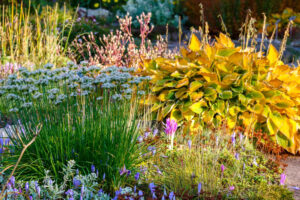
As fall settles in and the garden begins to fade, many of us feel the urge to tidy things up by cutting back perennials, raking leaves, and preparing for a clean slate come spring. But when it comes to perennial plants, a little mess can be a good thing.
Leaving some perennials standing through the winter isn’t just a lazy gardener’s excuse – it’s an important way to support wildlife, promote plant health, and even add winter interest to your landscape.
Seed Heads Feed the Birds
Many perennials produce seed heads that birds rely on throughout the colder months, when other food sources become scarce. Goldfinches, chickadees, and cardinals are just a few of the birds that will happily feast on seeds left in the garden.
Great perennials to leave up for seed heads include:
- Echinacea (coneflower): Loved by goldfinches.
- Rudbeckia (black-eyed Susan): Attracts finches and sparrows.
- Monarda (bee balm): Draws seed-eating birds and offers structure. Chickadees and titmice may forage the seed heads for both seeds and insects.
- Coreopsis: Provides seeds well into winter. When planted in groups Coreopsis will attract goldfinches, house finches and indigo buntings.
- Heliopsis helianthoides (False Sunflower): Provides a long bloom period and seed heads for finches and chickadees.
Hollow Stems Provide Shelter
Many native bees and beneficial insects overwinter in hollow or pithy stems. When we cut those stems to the ground in fall, we unintentionally remove crucial habitat.
Instead, wait until spring (around mid-April) before cutting these back. By then, most overwintering insects have emerged.
Plants with beneficial stem structures include:
- Joe Pye weed (Eutrochium spp.): Tall, pithy stems that native bees use.
- Penstemon: Attractive seed heads and valuable nesting sites.
- Mountain mint (Pycnanthemum spp.): A native powerhouse that supports pollinators in summer and offers overwintering habitat for beneficial insects.
- Milkweed: Monarchs may be long gone, but other insects use the stems.
- Agastache spp. (Anise Hyssop): Aromatic, tall stems remain upright which are excellent for native bees.
Winter Beauty and Structure
Tall perennials and ornamental grasses can add beauty to the winter garden, especially when their seed heads display a dusting of frost or snow. They catch the light, move in the breeze, and add much-needed texture to the winter garden.
Grasses and perennials with winter interest:
- Switchgrass (Panicum virgatum)
- Little bluestem (Schizachyrium scoparium)
- Sedum ‘Autumn Joy’: The flower heads persist in winter.
- Yarrow (Achillea millefolium): Dried heads offer structure and seeds.
- Perovskia atriplicifolia (Russian Sage: The silvery stems and dried flowers provide structure and sparkle in frost.
- Allium spp.: The seed heads remain as round orbs through much of the winter, providing a sculptural effect.
Tips for a Wildlife-Friendly Fall Clean-Up
- Cut back plants selectively. Tidy up diseased or floppy plants but leave healthy ones with seed heads and hollow stems.
- Leave leaf litter. Fallen leaves shelter butterflies, beetles, and other pollinators.
- Wait until temperatures consistently reach the 50s in spring before doing your major clean-up.
A Small Mess is a Big Help
By leaving some perennials standing through winter, you’re not neglecting your garden – you’re supporting an ecosystem! Birds, bees, and butterflies all benefit from a little extra shelter and food. Plus, you get the added bonus of a garden that still has texture and movement, even on the bleakest winter days.
This fall, consider putting the pruners down and letting nature do its thing. Your garden, and the creatures who call it home, will thank you come spring.
